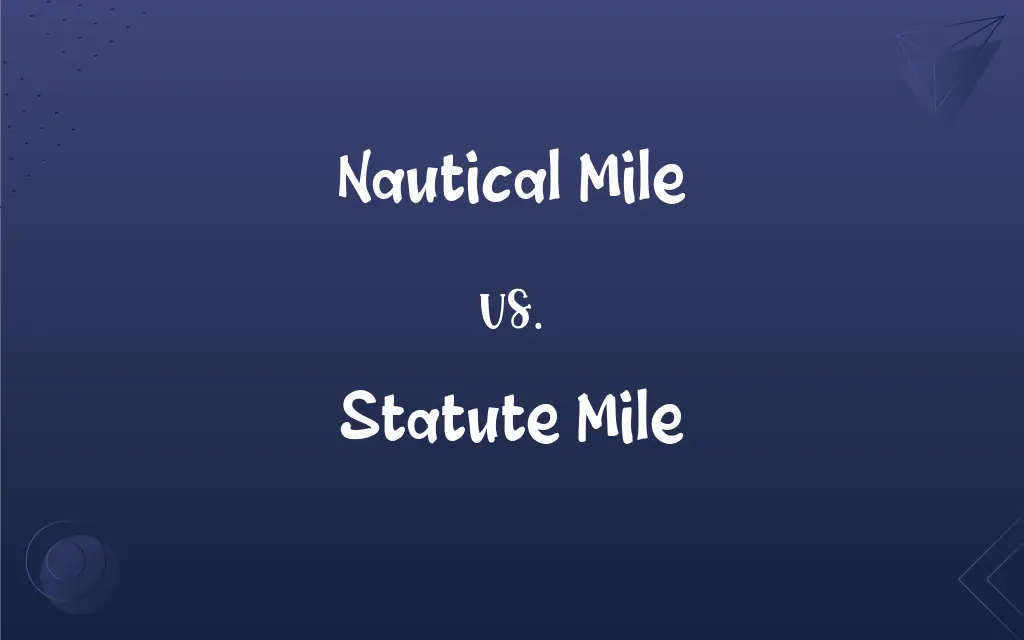Nautical Mile vs. Statute Mile: What's the Difference?
Edited by Aimie Carlson || By Janet White || Published on January 12, 2024
A nautical mile is a measurement used in maritime and aviation, equal to 1.852 kilometers, whereas a statute mile is a land-based measurement equal to 1.609 kilometers.

Key Differences
The nautical mile, primarily used in marine and air navigation, is based on the Earth's circumference, equating to one minute of latitude. The statute mile, on the other hand, is used for land distance and is derived from the Roman mile, measuring 5,280 feet.
Nautical miles are crucial in navigation due to their direct relationship with the Earth's latitude, making them ideal for charting sea and air routes. Statute miles are predominantly used in the United States and UK for road distances and are familiar in everyday use.
The concept of the nautical mile evolved from the need for precision in navigation, calculated from the Earth's meridians. The statute mile has its roots in the Roman Empire, initially defined as 1,000 paces.
The International Hydrographic Organization standardizes the nautical mile as exactly 1,852 meters. The statute mile, legally defined in the international yard and pound agreement of 1959, is exactly 1,609.344 meters.
For navigators and pilots, understanding the nautical mile is essential for accurate journey planning and fuel estimation. In contrast, the statute mile is a familiar unit for drivers and is used in legal speed limits and distance signage.
ADVERTISEMENT
Comparison Chart
Length
1,852 meters
1,609.344 meters
Usage
Marine and air navigation
Land-based distances
Basis
Earth's meridians (one minute of latitude)
Roman mile
Standardization
International Hydrographic Organization
International yard and pound agreement
Practical Use
Essential in navigation for calculating distances and fuel
Common in everyday life for road distances and speed limits
ADVERTISEMENT
Nautical Mile and Statute Mile Definitions
Nautical Mile
A unit of length used in maritime and aviation navigation.
The ship sailed 15 nautical miles northeast.
Statute Mile
A unit of distance used on land, especially in the United States and UK.
The next town is 5 statute miles down the road.
Nautical Mile
Equal to approximately 1.852 kilometers.
The island was about 50 nautical miles away, roughly 92.6 kilometers.
Statute Mile
Equal to exactly 1,609.344 meters or 5,280 feet.
The marathon is approximately 26.2 statute miles long.
Nautical Mile
Represents one minute of latitude.
The pilot adjusted the course by two nautical miles to align with the flight path.
Statute Mile
Derived from the Roman mile.
Historical texts often refer to distances in statute miles, harking back to Roman measurements.
Nautical Mile
Essential in charting sea and air routes.
The navigator calculated the route to be 300 nautical miles.
Statute Mile
Commonly used in road signage and speed limits.
The speed limit was 60 miles per hour, measured in statute miles.
Nautical Mile
Used internationally for defining territorial waters.
The exclusive economic zone extends 200 nautical miles from the coastline.
Statute Mile
Standard unit for measuring land distance in certain countries.
The hiking trail was marked every quarter statute mile for convenience.
FAQs
How is a statute mile different from a nautical mile?
A statute mile is a land-based measurement equal to 1.609 kilometers, shorter than a nautical mile.
Is the nautical mile universally standardized?
Yes, it is standardized as exactly 1,852 meters by the International Hydrographic Organization.
What is a nautical mile?
A unit of length used in maritime and aviation, equal to 1.852 kilometers.
Why is the nautical mile used in navigation?
It aligns with the Earth's latitude, making it ideal for precise maritime and aviation charting.
How did the statute mile originate?
It originated from the Roman mile, initially defined as 1,000 paces.
Do all countries use statute miles?
No, many countries use the metric system and measure distances in kilometers.
Is the nautical mile the same in all countries?
Yes, the nautical mile is internationally recognized and standardized.
How are statute miles marked in the UK and the USA?
They are marked on road signs and used for legal speed limits and distances.
Why does the USA still use statute miles?
It's part of the customary system of measurements inherited from British imperial units.
Where is the statute mile predominantly used?
Primarily in the United States and the UK for road distances.
Can GPS systems use both nautical and statute miles?
Yes, most GPS systems can display distances in both units.
How accurate are nautical mile measurements in navigation?
They are highly accurate, essential for precise charting in marine and aviation navigation.
Is the statute mile used in athletics?
Yes, races like marathons are often measured in statute miles in countries using this system.
Are statute miles used in air travel?
Air travel typically uses nautical miles or kilometers for more accuracy in navigation.
Are there conversion tools for these miles?
Yes, there are online calculators and tools for converting between nautical and statute miles.
Do sailors need to know both nautical and statute miles?
Familiarity with both is useful, but nautical miles are more critical for sailors.
Can nautical miles be used for land measurement?
While possible, they are not typically used for land measurement due to their specific design for navigation.
What is the historical significance of the nautical mile?
It was developed for precise navigation, considering the Earth's curvature and latitude.
How does weather affect nautical mile calculations?
Weather doesn't affect the measurement but can impact navigation and travel distance.
Has the definition of these miles changed over time?
Their lengths have been standardized, but the basic concept remains the same.
About Author
Written by
Janet WhiteJanet White has been an esteemed writer and blogger for Difference Wiki. Holding a Master's degree in Science and Medical Journalism from the prestigious Boston University, she has consistently demonstrated her expertise and passion for her field. When she's not immersed in her work, Janet relishes her time exercising, delving into a good book, and cherishing moments with friends and family.
Edited by
Aimie CarlsonAimie Carlson, holding a master's degree in English literature, is a fervent English language enthusiast. She lends her writing talents to Difference Wiki, a prominent website that specializes in comparisons, offering readers insightful analyses that both captivate and inform.































































